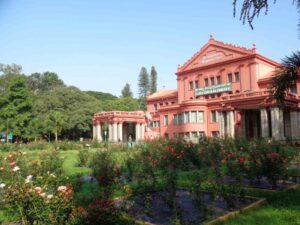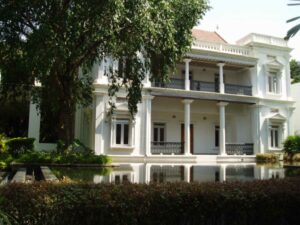Those designed by the colonists speak mostly of European classical influence; vernacular elements, too, found their way into the aesthetic.

Oriental Building, Bengaluru. (Supplied)
Chosen as the location of the British Cantonment in the early 1800s, Bengaluru’s influence of British rule pervaded the city, and many buildings and bungalows cemented its colonial legacy. After the 1881 Rendition, two administrations ruled the city—the Mysore Wodeyar and the British, who controlled the Civil & Military Station. Their impact resonated in the city’s culture and infrastructure for decades.
Post-independence and as the city developed, most buildings from this era bit the dust. Some are fighting to survive, thanks to heritage conservationists. The few left standing have witnessed the shift in times. They have changed hands and received a new lease of life.
These buildings are remarkable for their architecture. While those designed by the colonists speak mostly of European classical influence, vernacular elements, too, found their way into the aesthetic. However, the stories of these buildings are not of brick-and-mortar alone but also of the intangible history that weaves around their columns and roofs, which has, over the centuries, brought them into the folds of Bengaluru’s heritage.

Seshadri Iyer Memorial Hall, Bengaluru
The Seshadri Memorial Hall is better known as the State Central Library. Today, it sits red and splendid in Cubbon Park, which was later extended to include the building. It was built in the early 1900s to commemorate Mysore state’s longest-serving dewan, Sir Seshadri Iyer, known as the “Maker of Modern Bangalore.” His contributions include commissioning the Shivanasamudra hydroelectric project and supplying the harnessed electricity to the Kolar Gold Mines.
His bronze statue, sculpted by William Robert Colton, stands in the rose garden before the building. The public-funded building, initiated by Lord Curzon with Richard Sankey as the architect, is known for its gables, granite Tuscan and Corinthian columns, an apsidal side, and a Jack-arch roof.
According to Meera Iyer in Discovering Bengaluru, the building was occupied by a club, an educational museum, and a restaurant before the public library fully took over. Started in 1915, the library housed four thousand books, and it numbers over three lakhs today. A winner of the Raja Rammohan Roy Library Foundation Award as the Best State Central Library in 1999, it is a free reference library. It includes a Braille section and a children’s library.
In the 1860s, a British civil servant, Lancelot Ricketts, built the Beaulieu (“beautiful place”) reminiscent of palatial English homes on a 24-acre estate encompassing farms and agricultural land. A variety of potatoes he grew on this estate became known as Ricketts. Ricketts was born in Bengaluru, while his father served the British army in Madras. He held various important positions, including that of director of Lalbagh and founder-editor of the bilingual Mysore Gazette, thanks to his fluency in Kannada.
T P Issar in The City Beautiful lauds the building for its pleasing composition with flat arches, wooden fretwork on gables, and pointed ridge tiles. The Beaulieu was bought by the Mysore dewan Sir TRA Thumboo Chetty in 1900 on behalf of Chamaraja Wodeyar X’s daughter Princess Jaya Lakshammanni who was married to M Kantaraj Urs, the Dewan of Mysore. In 1966, the Beaulieu became the official address of the Chief Postmaster General, Bengaluru Karnataka Circle. Heritage Beku’s Priya Chetty-Rajagopal’s efforts led to the building’s original entrance being restored in 2022.
The European-Classical-style Balabrooie Guest House, with its wide verandah embellished with wooden trellis, is set on a 14-acre property with over a hundred trees and is surrounded by other heritage properties. Built in 1850, it has been home to renowned statespeople. One of its earliest residents was Sir Mark Cubbon, the British Commissioner, after whom Cubbon Park (officially Sri Chamarajendra Wodeyar Park) and Cubbonpet were named.
From the Isle of Man, Cubbon named it Balabrooie, an Irish term meaning “farm by the river.” The land once belonged to the former headmaster of Central College, Rev. John Garrett. After the 1881 Rendition, it belonged to Chamaraja Wodeyar, with the Dewan of Mysore, Sir M Visveswaraya, using Balabrooie as an office.
In addition to being the residence of British Commissioners, Mysore Dewans, and a few post-Independent India’s chief ministers, the guest house also hosted national leaders such as Mahatma Gandhi, Jawaharlal Nehru, and Rabindranath Tagore. Funnily, a superstition about the guest house’s vastu led to the chief ministers of the state refusing to live there.
In 2023, the Department of Personnel and Administrative Reforms handed the property over to the Public Works Department for renovations. The guest house now has a new role as a Constitution Club, a move severely criticized.
The Madras Engineer Group, also known as the Madras Sappers, built the Oriental building at the Anil Kumble Circle (formerly Oriental Circle) in 1926. It became the office of the Oriental Life Insurance Company, the first life insurance company established in India in 1818 in Calcutta to serve the Britishers.
The Sappers, who dug trenches and built bridges, moved to Bangalore in 1834 with their headquarters near Ulsoor Lake. They built civil and military buildings in the city, including the BRV theatre, now the Golden Palm Army Canteen. The classical-style stone building is a linear structure with two upper storeys. The façade displays a series of arch-framed windows, balustraded railings, and pilasters. Issar notes the window shades over the ground-floor windows as a curious feature in The City Beautiful.
Following the nationalization of life insurance around 1956, the Life Insurance of India (LIC) came into effect. The Oriental building now serves as the offices of LIC.

Manikyavelu Mansion, Bengaluru.
Another heritage property near the Balabrooie Guest House is the Manikyavelu Mansion, better known as the National Gallery of Modern Art (NGMA). The century-old bungalow in a 3.5-acre plot of land dates back to the early 1900s. According to Meera Iyer in an article published in the Deccan Herald, Haji Sir Ismail Sait built it and called it “Ismailia.”
A two-story brick and mud-plastered building rose in the colonial style with local design elements. The Yuvaraja of Mysore, Kanteerava Narasimharaja Wodeyar, bought the mansion.
Its next owner was Vilum Manikyavelu Mudaliar, a commoner. Reportedly, someone once refused him entry into the mansion. After acquiring wealth through mines and other businesses, he bought the house around the 1930s. The house went under the hammer following tax issues. It housed UN offices for a time. It is now with the Housing Board, leased to the Ministry of Culture.
Renovated in 2000 by Naresh Narasimhan of Venkataramanan Associates, it now houses the NGMA. The original mansion underwent repairs but remains unchanged. The additions included a cafeteria and two galleries in a style similar to the original building, with a mirror pool at the centre. The grounds boast centuries-old trees carefully preserved through the renovations. In fact, the museum, which began operations here in 2009, periodically holds arboretum walks on its premises.
The Raj Bhavan is invisible behind high compound walls and tight security. The property originally housed the British Resident. Sir Mark Cubbon, a British Commissioner from 1834 to 1861, purchased the property and built the bungalow with stables for his many horses. It was a one-level bungalow with pilasters, pedimented windows, and an impressive porch with tall columns. The second storey came up in 1967. Moreover, horse trader Aga Ali Asker had his eye on it, but Cubbon’s successor, Lewin Benthem Bowring, bought the house for the government when it came up for sale.
Many additions have sprung since. The ballroom, called the Serapis Room, commemorated the 1874 visit of the Prince of Wales, Queen Victoria’s son, to India on a ship called Serapis. Following the 1881 Rendition, when the role of Commissioner ended, the bungalow shifted to the British Resident once again, known as the Commissioner’s Bungalow and, later, Residence.
After the Independence in 1947, the Residency ended. The position of the Raj Pramukh, or Governor, created in independent India, and this bungalow became the Governor’s home and became known as Raj Bhavan. The first governor was Jayachamaraja Wodeyar, who preferred living in the Bangalore Palace. His successor, General Sri Nagesh, moved into the Raj Bhavan in 1964 and became the first governor to call it his official residence. The property includes a landscaped garden with over three thousand plants, a waterfall, and a glass house, added in 2000 to hold state functions.
Moreover, the city’s fast-paced and unchecked urban development has taken its toll on heritage structures that thrived in the sprawling space and greenery Bengaluru once offered. Only long-term vision and clear-cut frameworks can create a defined and new aesthetic identity for the city, free from nostalgia and cognizant of the present state of affairs.
(Anuradha Prasad is a writer and editor based in Bangalore. She runs the Instagram page @knowbangalore, documenting the city’s history and heritage, and freelances as a heritage walking tour lead. Views are personal.)

Jul 26, 2024

Jul 21, 2024

Jul 20, 2024

Jul 20, 2024

Jul 19, 2024

Jul 18, 2024